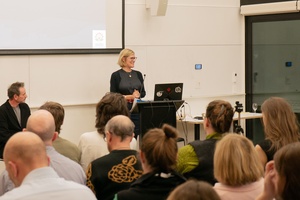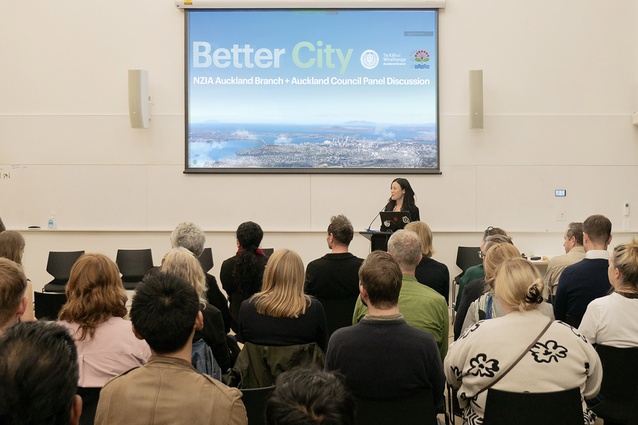Better City hui calls for quality intensification.
As Tāmaki Makaurau faces growing pressure to intensify amidst concurrent housing and climate crises, how can the NZIA and Auckland Council collaborate across design, planning and policy to deliver density without compromising liveability, equity or sustainability?
This question underpinned the recent ‘Better City’ hui, hosted by the Te Kāhui Whaihanga New Zealand Institute of Architects (NZIA), which brought together six professionals from both NZIA and Auckland Council (AC) organisations.
Initiated by Charissa Snijders, led by Jenny Chen and moderated by Tom Locke, the panel explored intensification from macro city planning to site-specific architecture.

Otene Reweti, kaumātua of HomeGround, welcomed everyone with a karakia referencing the importance of sharing our ‘baskets of knowledge’, after which John Duguid, Auckland Council’s General Manager of Planning and Resource Consents, kicked off the conversation, speaking to the region’s current state of regulatory limbo following the 2023 transition from Labour to National. Labour issued a national directive via the National Policy Statement on Urban Development (NPS-UD) and amendments to the Resource Management Act (RMA), which mandated councils in high-growth areas to enable more residential development.

Auckland Council responded with Proposed Plan Change 78 (PC78), a strategic amendment to the Auckland Unitary Plan (AUP). PC78 proposed a node-based intensification model, targeting development around metropolitan centres, public transport corridors and employment opportunities to support compact, connected, walkable communities that reduce car dependency and maximise existing infrastructure. Meanwhile, the Medium Density Residential Standards (MDRS), a component of PC78, took a blanket approach, enabling the construction of up to three dwellings of three storeys on most residential sites without resource consent (RC).
However, Duguid noted that the current National government is working to make MDRS optional, prioritising private property rights and proposing to constrain PC78 to central Auckland only. Ultimately, this undermines the council’s ability to steer development, leading to over-intensification in poorly-serviced suburbs and missing opportunities for smart growth in key areas.
The tension between strategic, equitable intensification in the right places and reactive development in the wrong places was a recurring theme that emerged throughout the discussion. Under the current RMA, councils are legally required to grant RC to development proposals that meet permitted standards, regardless of infrastructure capacity and neighbourhood context. Urban Design Manager, Lisa Dunshea, explained that this has led to disproportionate concentrations of medium density housing (MDH) in South and West Auckland, areas already under pressure.
At an architectural scale, inconsistency in design quality is a growing concern. Arron Kong, Lead Architect at Auckland Council, observed that while some MDHs are well done, many lack fundamental design considerations, such as site orientation, privacy, strong internal layouts and appropriate materiality. Discrepancies between what is consented and constructed often occur due to budget constraints and an absence of architectural involvement post-RC. These developments tend to cluster in lower-income, vulnerable and under-resourced areas, which Locke put down to successive governments seeking quick and easy solutions to housing affordability without considering all the related components of healthy cities.
The implications extend beyond liveability to the economic. On land zoned for increased height and density under PC78, developers have sometimes only delivered MDH, subsequently undercutting housing yield and diminishing site value. Without a clearer plan, inefficient land use will continue to perpetuate sprawl, pressurise greenfields and undermine climate goals.
This led the conversation to climate resilience, as architect Charissa Snijders shared that the built environment contributes to a staggering 42% of global carbon emissions annually.
She urged both the NZIA and AC to abandon perceptions that density, affordability and sustainability are mutually exclusive, stating these must be addressed in tandem, not in tension.
Snjiders called for systemic change, emphasising the need for more adaptive governance and targeted investment at a planning level to prioritise climate-conscious, resilient intensification. At the architectural scale, this means leading with sustainable design, engaging net-zero targets and frameworks such as NZGBC Green Star, and implementing ethical materiality. The venue for the evening’s event, HomeGround, a mass timber building by Stevens Lawson Architects, embodies this ethos, proving that density and sustainability can be synonymous.
By way of support, Locke referenced the Sydney Design Excellence Programme, which offers incentives such as extra floor area or height to developers whose projects demonstrate outstanding design and sustainability. A similar approach could be explored in Auckland to reward innovation, ambition and sustainability beyond compliance with regulatory minimums.
Looking ahead, collaboration is critical. Erin Quin, Auckland Urban Design Panel Lead, acknowledged how NZIA and AC operate in a space of shared responsibility for shaping how people experience Tāmaki Makaurau. Quin advocated for early engagement with the Auckland Urban Design Panel, which incorporates interdisciplinary design input to ensure equitable, resilient and liveable outcomes. She also encouraged more voices from the architecture
profession to make submissions. Quin concluded, “Design isn’t neutral; it reflects values, priorities and assumptions.”
As Tāmaki Makaurau navigates the demands of intensification, climate pressures and complexities of evolving regulatory frameworks, compounded by the housing and climate crises, a better city hinges on cross-sector collaboration, bipartisan policy support and clearer design goals.
Better City was shaped through early kaupapa-setting conversations between Jenny Chen, Charissa Snijders, Lisa Dunshea, Tom Locke, Mark Abbot and John Duguid. As Jenny Chen concluded, “Our purpose is to strengthen relationships between our profession and council to drive better design outcomes; collaborative leadership can guide a more intentional urban future.”
The second Better City hui, is taking place in November 2025.










